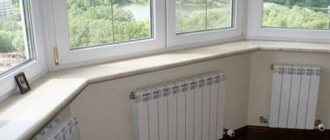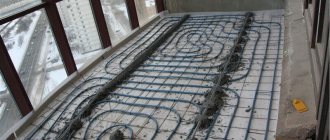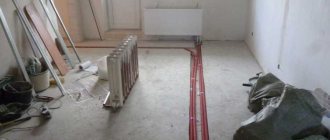Question: Is it possible to move the AGV from the kitchen to the loggia. Loggia height 2.6, 6 sq.m., insulated, ventilated. Multi-apartment building, apartment on the second floor.
Answer: Yes you can. But not on your own! Contact the gas service of your district (city) in writing with a request to issue you technical specifications for moving your heating appliance (AGV) from the kitchen to the loggia. Be sure to indicate the dimensions of the loggia and make a reference to the Code of Rules SP 62.13330.2011 “Gas distribution systems”, Section 7 “Internal gas pipelines”, which allows the installation of boiler rooms in non-residential premises of apartment buildings. Good luck.
Added: 11/19/2013 11:19
Discussion of the issue on the forum:
Other publications in the section “Engineering systems for high-rise buildings. Water. Heating. Gas. Electric."
Question: Is it possible for a gas pipe to go through the bathroom, this pipe from the meter to the boiler Answer: According to the requirements of the Code of Rules 62.13330.2011 “Gas distribution systems.” Updated version of SNiP 42-01-2002. Section 7 “Internal gas pipelines”: – clause 7.6 If necessary.
Question: In a store with one room of 24 m2 and a second room of 24 m2, which infrared heater should I buy, what power and how much energy will it consume? Answer: If your store has no other heating source and you want to heat only with infrared heaters in winter.
Question: Is it possible to install a gas water heater with a closed chamber in the kitchen, the kitchen volume is 30 cubic meters, there is a window and a separate small window, also 1 ventilation duct, apartment on the 3rd floor of a 6-story building. Answer: Of course you can, but subject to the requirements of regulatory documents. It is necessary to provide.
#1 Offline blizzard
Twice flame hero
- Forumets
- 4,235 Posts:
- Auto: 11173
Attached files:
- IMG-20180608-WA0092.jpeg 128.4 Kb 0 downloads
#2 Offline December
Four times flame hero
Modified: December, 09/20/2018 – 23:05
#3 Offline Mikhail
Knight of the Order of the Flame
- Car: , Kayron
It is necessary to agree. Not only with gas workers, but also with management companies (architecture). But we forget about this. If this pipe is only for air intake, and combustion products are discharged into another chimney, then you can: 1. Extend the pipe or turn it through the frame of the future window to the street. 2. Leave the balcony window ajar. Unless, of course, you plan to have an insulated balcony, which also requires permission. Possible problems: – the boiler may not have enough air; – with the management company, architecture, gas workers, housing inspection.
I wonder if the vehicle follows the advice provided, how long will it take for the news to talk about another domestic gas explosion in Rostov?
Legal aspect
Having an autonomous heating system in an apartment is a significant advantage for this type of property. Usually, communications in the house are shared, so the air temperature in the apartment depends not on the wishes of its owners, but on the decision of the management company, which monitors the condition of the heating networks. And, by the way, it does not always quickly respond to changes in the weather temperature: first in February you have to turn on the air heaters, then in April you have to open the windows and “heat” the street.
In order to separate from general communications and have your own system, you must strictly follow the laws. The priority in this matter is the following rule: reconstruction of the heating system should not harm other residents of this house or the building itself.
The transfer of heating (as well as water supply) communications, even within the same apartment, is carried out exclusively according to the project agreed upon by the BTI. First you need to complete the theoretical stage - make calculations, draw a new floor plan. Especially if we are talking about installing an individual boiler in an apartment for the first time. And even more so if this unit is planned to be placed on a balcony or loggia.
According to current sanitary standards and regulations (SNiP), the installation of a boiler for heating apartments can be done in kitchens or in rooms specially designated for this purpose, called heat generator rooms (clause 4.2.3).
But there are few apartments with boiler rooms in the new building, and practically none in the old one. There is no talk at this point about installing the boiler on the loggia.
Theoretically, this can be done if the loggia is requalified as a heat generator. To do this you need:
- glaze the room with no less than two-chamber packages;
- insulate it in such a way that the walls on the apartment side are finished with fire-resistant materials;
- prepare a plan for supplying gas to the boiler and the entire heating system;
- coordinate it with the technical inventory bureau.
Battery on the balcony in an apartment with individual heating
Residents of apartments with a loggia or balcony are lucky because they have additional space that can be turned into a full-fledged room. Many people glaze and insulate their balconies to make them comfortable to stay in in winter. If you want to set up a workshop or office there, then insulation is not enough. It is also necessary to provide high-quality heating for the balcony or loggia.
By law, the transfer, installation or replacement of heating and other utility networks in an apartment are classified as reconstruction. For these actions it is necessary to obtain permission from the BTI. If you are going to connect the heating on the balcony to the water supply or central heating, you will need such permission.
Typically, such a transfer of a central heating system is prohibited, and here's why:
- If there are radiators or water-heated floors on the balcony, they may freeze in winter and burst. Then it will flood you and your neighbors below. This problem can be solved by good insulation of the balcony. But you will have to prove to the inspectors that you have insulated it well enough.
- Connecting radiators to the heating system of the whole house will weaken the water pressure, and the radiators will become colder for everyone. Naturally, other residents will be against it.
You can make such a transfer without permission. But problems will arise when this is noticed. For example, when selling an apartment, you will provide new residents with a technical passport. All utility networks of the apartment must be included in it. And if the batteries are installed illegally, then they are not included in the plan. In this case, you will need to pay a fine and coordinate the heating or return everything to its previous form. Therefore, think about whether it makes sense to carry out uncoordinated work.
Please also note that regional authorities may ban the removal of the radiator from the loggia.
For example, in Moscow there is such a document: regardless of the insulation of the balcony, it is forbidden to remove batteries. For Muscovites, it is illegal to place a heating radiator on the balcony.
So, to avoid fines, think about other options for heating your balcony:
- electric heated floor;
- fan heater;
- oil or infrared heater;
- gas convector.
These methods do not need to be coordinated, since they do not affect the utility networks of the house and are easier to implement than moving batteries. You can use them, and you definitely won’t have to pay a fine.
We will not consider solar panels for a balcony separately, since it makes no sense to use them for a small space. The use of solar collectors and batteries is advisable if you plan to heat water or heat a house, for example, in a country house.
One of the most effective ways to insulate a balcony is to install an electric heated floor yourself. There are several options that are not prohibited by law, and it is up to you to decide which one makes sense to choose.
Heating mats are a material in the form of a mesh to which cables are attached in the form of a snake. You can do the installation yourself. The mat can be cut into pieces if the room requires it. DIY installation procedure:
- Check the system resistance and clean the floor from dust and building materials.
- You need to make a groove in the floor for the temperature sensor and in the wall for the cable and thermostat.
- Prime the concrete floor.
- Lay the mat on the floor and cut if necessary. Step back 5 cm from the walls.
- Place the tube with the temperature sensor and connect it to the thermostat.
- Seal the groove with tile grout.
- Apply tile adhesive to the mats.
- Install the tile. Turn on the heated floor after the tiles have completely dried.
Infrared floors are special elements that heat a room through radiation. This type is safer than the previous one. It also consumes less electricity. It is easier and faster to install than mats.
Cable system is a common type of heating. It must be installed on a layer of insulation, otherwise the heat will go down. The top of such a warm floor is covered with a cement-sand screed. The disadvantages of such a coating include drying: you need to wait three weeks until the screed dries and the floor can be used.
Methods of electric heating of a balcony also include a fan heater and heaters. These methods are the most obvious, they do not require additional installation, and their transfer does not require the use of special tools. Moreover, they are not prohibited by law. The downside of heaters is that they dry out the air a lot. If you have plants on your balcony, they are unlikely to like it.
A fan heater is a compact device that sucks in cold room air, heats it and releases it back.
It is best to install it on an insulated balcony. It can quickly warm up the entire balcony, but when used for a long time it starts to heat up on its own. Therefore, it must be turned off periodically. Another disadvantage is noise.
An oil heater is an electrical device that uses mineral oil as a coolant. It can be set to one of the operating modes. It will heat up and turn off when it reaches a certain temperature. After it cools down, the heater turns on again. To use this device on a balcony, you need to insulate it, since there will be no effect in case of drafts. Warm air will simply evaporate from the room.
An infrared heater is a lamp that heats a room and objects in it with radiation. It adds its own illumination to the sunlight. The disadvantage of such a heater is the fragility of the lamp, as well as its temperature - 200 degrees. This type of heater consumes less electricity and has the highest performance compared to convector and oil heaters.
There is no point in installing a gas boiler to heat the loggia - it is expensive and impractical. Therefore, in the case of gas heating, we are talking about installing a gas convector. If you do not want to transfer central heating to the balcony, it makes sense to use a gas convector:
- Suitable for owners of apartments with gas pipelines, since gas is cheaper than electricity. Compact devices consume little fuel and effectively heat the room. If your balcony faces the sunny side, it will be heated by the sun and gas.
- The convector can be connected to the gas network of the entire house (although such redevelopment will also have to be approved) or to a gas cylinder. The gas convector is easy to install.
- It requires only one hole to release exhaust gases to the street. The law allows such manipulations.
- The devices are equipped with gas leakage protection systems.
If you want to try to coordinate the output of the heating radiator to the balcony, this can be done after installation. First you need to select a battery. It can be cast iron, steel, aluminum, bimetallic.
You can remove the battery yourself, or you can contact a professional plumber. The last method is more reliable if you do not have special skills.
If you want to do it yourself, the next step is to choose the type of attachment of the new radiator to the existing one. After that, buy all the necessary materials: taps, plugs, tubes, sealant. Connect the tubes to the battery and lead them out to the balcony through the holes in the wall. Hang a new radiator. Don't forget to insulate all connections with fum tape.
Water heated floor diagram
Before installing a water heated floor, it is necessary to make a calculation. There are two ways to lay pipes:
- Snail. It is a spiral - pipes stretch from the central element to the walls.
- Snake. The pipes are laid in a snake pattern from one wall to the other. It makes sense to make a snail on the balcony, as it ensures uniform heating.
If the floor is concrete, then the thermal circuit must be drawn deep into the screed. It is imperative to insulate the floor and the entire balcony. Insulating materials, reinforcing mesh, and water pipes are laid on the floor. They need to be attached to the grid. After this, the system is connected to the water supply and the coolant is filled in, turned on, and left for a day for testing. At the final stage, everything is filled with a special solution and the floor covering is laid.
There are several ways to install heating on a balcony. You must decide for yourself whether you will install a heated floor or remove the radiator. But do not forget about the laws and the need for approvals for the transfer of batteries. Think about whether it makes sense to go through all these procedures, or whether it is better to use household appliances that do not require special installation.
An insulated loggia is an excellent option for expanding the usable area of an apartment. At the same time, high-quality glazing, insulation and waterproofing are not enough for a comfortable stay in the loggia throughout the year. This is why many owners decide to move the battery to the loggia.
It’s worth noting right away that this is a rather labor-intensive process, which, among other things, is not so easy to coordinate with the housing inspection.
First you need to develop a project, then obtain permits, and only then carry out all the necessary installation work, which is not as simple as it seems.
Lonely battery on the loggia.
The idea of moving a heating radiator to the loggia is a good idea for creating a comfortable environment in this non-residential space during the cold season.
In this case, the following must be taken into account:
- To carry out such work, you must obtain permission. You can’t just take and dismantle the heating radiator in the room and install it in the loggia. It is also prohibited to add new elements to the apartment’s heating system without approval from the relevant authorities. At the same time, no one can guarantee that after contacting the housing inspection it will be possible to get a positive response from them regarding the transfer of the battery to the loggia - homeowners are not always given such permissions. In addition, this is a rather complex bureaucratic procedure that can last more than one month.
- Perform accurate calculations. All work must be performed professionally, therefore, calculations regarding the number of sections of the heating radiator in the loggia, its location, ambient temperature, and pressure in the pipeline must be entrusted to professionals. After all, adding a new battery is fraught with consequences for the apartment owners and their neighbors.
- Carrying out insulation work. Of course, there is no point in moving the battery into the loggia if high-quality glazing and insulation have not been done. All surfaces of the loggia must be insulated. Glazing – preferably two-chamber or three-chamber.
The housing inspection will require apartment owners to:
- Professionally performed thermal conductivity calculations;
- A professional opinion from specialists that the water in the heating radiator will not freeze outside the apartment;
- The redevelopment project and a number of other documents, the list of which must be clarified with the regional housing inspection.
Moreover, the most difficult stage will be the development of a redevelopment project, which involves changing the status of the loggia.
From a non-residential premises it must be transformed, strictly according to the documents, into a living room. The author of the apartment building project (usually a company or design institute) is responsible for issuing such documents.
It is worth noting that the development of the status change project itself is carried out by specialized firms.
In a project, the specialist responsible for its development must take into account all the nuances and standards (construction, sanitary, fire safety, engineering, communications, etc.). Of course, before developing a project, it is necessary to properly insulate the room and take into account possible risks.
The design institute usually gives such permissions if the removal of the central heating radiator does not affect the condition of the entire building. That is why, in most cases, there are no problems with obtaining permission in new buildings and relatively new houses, while in houses of the old housing stock it will be practically impossible to carry out such work officially.
After all this, it is necessary to develop design documentation, which must be agreed upon with Rospotrebnadzor and the fire service. At the end of everything, it is necessary to register the redevelopment with the BTI, where the corresponding changes will be made to the title documents.
Naturally, very often you can find cases where the removal of a heating radiator into the loggia is carried out without any approval. Moreover, all installation work is carried out independently, because many mechanics and craftsmen will definitely ask to see permits before starting the installation of a heating radiator. If they do not exist, then few specialists will engage in such work.
Illegal removal of a heating radiator onto a balcony is punishable by a fine. In accordance with the current Code of the Russian Federation on Administrative Offenses, the fine is several thousand rubles. In addition, it will be necessary to carry out work to dismantle the radiator and return everything to its place.
However, after the work has been completed, you can try to get started with paperwork and legalization of the redevelopment.
Although this is a complex process, such a development of events still has the right to life. If the apartment owner refuses to pay fines or remove the heating radiator from the loggia, then the housing company may take extreme measures - go to the courts.
After obtaining permission and completing all documents for the removal of the central heating radiator to the loggia, work can begin. In this case, it is necessary to take into account all the nuances that will allow you to correctly remove the heating radiator:
- An excellent solution for a loggia would be modern aluminum radiators, which have many advantages: light weight and modest size, the ability to work with fairly high pressure in the pipeline, and an increased degree of thermal conductivity (which, in principle, is what is required to generate heat).
- If aluminum batteries were chosen, then the number of heating radiator sections must be calculated using the formula - one section per two square meters of balcony area. For example, if the balcony has an area of 6 sq. m., then an aluminum radiator with three to four sections will be enough.
- Mounting the battery on the balcony, regardless of its type, must be done using three brackets: one upper and two lower. If the heating radiator is large, you can add another top mount.
- To obtain a high degree of heat transfer, it is necessary to maintain the following distances from the main structural elements of the loggia. The battery should be installed 14 cm from the floor, 2-3 cm from the wall, 8-12 cm from the window.
- In addition, before installation, it is recommended to lay a foil screen behind the intended installation of the heating radiator, which will provide warmth and comfort.
Before heating the loggia, it is necessary to dismantle the old radiator in the room, if planned.
To complete the work you will need: pipes, brackets, a hammer drill, fittings, a grinder, a soldering iron.
In most cases, installation of a heating radiator in a loggia is carried out in the following sequence:
- The first step is to cut off the battery in the room (kitchen, living room, bedroom). You need to cut in two places: near the battery and the pipe (about 100 mm from the intended connection area). After this, you need to drill holes in the wall with a diameter of 20 mm, which will allow you to carry the riser into the loggia. First, the roll is removed, after which the fittings, connections, and finally the riser itself are installed.
- A good solution would be to choose polypropylene pipes, which have excellent performance characteristics. In addition, when using them, it will be easier to complete all installation work yourself.
- Next, you need to attach the new battery to the wall in the loggia in order to use a level to mark the areas for future fastenings. Then the brackets are installed. It was already noted above that it is necessary to install two lower and one upper bracket. For a small radiator this will be quite enough.
- Hanging the battery on the loggia on the installed brackets is quite simple. After installing the radiator, Mayevsky plugs and taps are installed.
- If polypropylene pipes were used, then various elements (fittings, connections) were attached to them.
- After this, the taps are installed and the pipes are connected. It is imperative to check the tightness of the installed pipes and all connections.
In the loggia, the battery can be connected in three ways:
- With jumper and tap. An excellent solution for this room, because all the heat will pass through the radiator without any loss;
- With jumper, but without tap. The presence of a jumper allows you to close the flow of hot water when the air in the room gets too hot;
- Without jumper, but with tap. The presence of such a solution allows not only to shut off the flow of water, but also to temporarily dismantle the radiator to carry out the necessary work.
Removing the battery allows you to make a full-fledged room in the loggia for permanent residence or solving any other problems. Of course, everything must be coordinated with the housing inspection and other regulatory authorities.
If permission has not been obtained from the authorities, then as an alternative option you can consider installing a heated floor system, which is also ideal for loggias and balconies.
If possible, it is best to entrust the work to professionals who are familiar with the features of installing heating radiators and putting them into operation.
An innovator's view
In fact, before making plans and diagrams, you need to decide - is it really worth moving the main heating unit to the loggia and thereby connecting the loggia to the apartment’s general heating system?
It’s one thing if we are talking about the initial installation of a boiler in an apartment. And it’s completely different if we’re talking about the reconstruction of an existing system. Moving gas equipment is a very expensive business. If the goal is to make the loggia a heated area, it may make sense to consider individual heating here, or simply connect the radiator installed here to an already functioning heating system.
It makes sense to connect a loggia to general heating communications if it is used not purely for technical needs, but as a living space - for example, an office or a dining room. If it is really possible to successfully install a boiler here and it is difficult to find the best place in the entire apartment, then you need to contact a specialist who will prepare a new project.
If you do the redevelopment yourself, without the approval of the responsible authorities, if such “amateur activity” is detected, the BTI may oblige you to return everything to its place in accordance with the previous plan approved by them. And these are additional costs, and sometimes very significant ones. Therefore, you should not try to solve the issue of moving the boiler to the loggia as quickly as possible: everything must be done step by step, competently and correctly from a legal point of view.
Is it worth installing a boiler on a loggia?
Before converting the loggia into a furnace room, you should once again weigh everything carefully - is it really necessary to move the gas boiler to the loggia. It’s one thing if the unit is being installed for the first time, and there is simply no other place for installation. And it’s completely different if you plan to move an existing gas boiler to the loggia. Remaking gas equipment is not a cheap pleasure.
Relocation of a gas boiler - approval and stages
Rules and regulations for installing a gas boiler
If you just want to make the loggia heated, then it is more advisable to think about alternative heating sources:
Using one of the listed options will save you from unnecessary expenses and a lot of time wasted on coordinating a new heating project with all sorts of authorities.
If you nevertheless decide to install a gas boiler on a loggia, this is only advisable if it will be used not as a storage room, but as part of a living space, for example, a kitchen or office. Then you should go and order a project for the future system from a specialist.
Unauthorized alteration of the heating may result in the inspection authorities levying a fine and forcing the heating system to be returned in accordance with the original plan. And this will again entail considerable costs.
Note! The owner of an apartment with improperly altered heating will face problems when selling it. Illegally installed communications must be included in the housing registration certificate.
Source
Alternative heating options for the loggia
If the apartment has an existing heating system with a gas boiler, it may make sense to provide one of the following heating options for the loggia:
- warm electric floors;
- warm water floors;
- electric convector;
- oil heater.
Using one of these options will allow you to avoid redevelopment of the apartment, and therefore save financial resources. In addition, moving boiler heating to the balcony entails the appearance of at least two additional pipes in the room, which can cause difficulties, in particular, with the arrangement of furniture.
Placing the boiler on the loggia is theoretically possible and practically feasible, but this is not always the most optimal solution.
Installing a gas boiler on a loggia or balcony
Not the most popular, but sometimes common way to heat an apartment is to install a gas boiler on the loggia. There are many discussions and disputes on forums about the possibility of placing the unit in a given location. Of course, if there are more suitable places, for example in the kitchen or bathroom, then it is better to install the boiler there. Placement on the loggia can only be done as a last resort.











